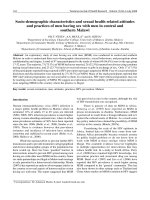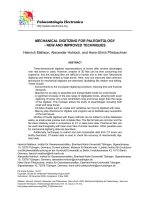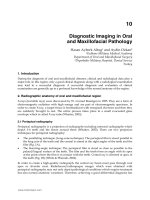TRENDS IN IMMUNOLABELLED AND RELATED TECHNIQUES doc
Bạn đang xem bản rút gọn của tài liệu. Xem và tải ngay bản đầy đủ của tài liệu tại đây (13.51 MB, 370 trang )
TRENDS IN
IMMUNOLABELLED AND
RELATED TECHNIQUES
Edited by Eltayb Abuelzein
Trends in Immunolabelled and Related Techniques
Edited by Eltayb Abuelzein
Published by InTech
Janeza Trdine 9, 51000 Rijeka, Croatia
Copyright © 2012 InTech
All chapters are Open Access distributed under the Creative Commons Attribution 3.0
license, which allows users to download, copy and build upon published articles even for
commercial purposes, as long as the author and publisher are properly credited, which
ensures maximum dissemination and a wider impact of our publications. After this work
has been published by InTech, authors have the right to republish it, in whole or part, in
any publication of which they are the author, and to make other personal use of the
work. Any republication, referencing or personal use of the work must explicitly identify
the original source.
As for readers, this license allows users to download, copy and build upon published
chapters even for commercial purposes, as long as the author and publisher are properly
credited, which ensures maximum dissemination and a wider impact of our publications.
Notice
Statements and opinions expressed in the chapters are these of the individual contributors
and not necessarily those of the editors or publisher. No responsibility is accepted for the
accuracy of information contained in the published chapters. The publisher assumes no
responsibility for any damage or injury to persons or property arising out of the use of any
materials, instructions, methods or ideas contained in the book.
Publishing Process Manager Maja Bozicevic
Technical Editor Teodora Smiljanic
Cover Designer InTech Design Team
First published April, 2012
Printed in Croatia
A free online edition of this book is available at www.intechopen.com
Additional hard copies can be obtained from
Trends in Immunolabelled and Related Techniques, Edited by Eltayb Abuelzein
p. cm.
ISBN 978-953-51-0570-1
Contents
Preface IX
Section 1 Emerging Uni-and-Multiplex Immunolabeled Methods 1
Chapter 1 Utility of One Step Immunoassay in Detecting
False Negativity in Routine Blood Bank Screening
of Infectious Diseases 3
Kafil Akhtar
Chapter 2 Assays for Assessing the Compatibility of Therapeutic
Proteins with Flexible Drug Containers 17
Shawn F. Bairstow and Sarah E. Lee
Chapter 3 Evaluation of an Immuno-Chromatographic Detection
System for Shiga Toxins and the E. coli O157 Antigen 29
Ylanna Burgos and Lothar Beutin
Chapter 4 Use of Antibodies in Immunocytochemistry 41
Hakkı Dalçık and Cannur Dalçık
Chapter 5 Recent Progress in Noncompetitive
Hapten Immunoassays: A Review 53
Mingtao Fan and Jiang He
Chapter 6 Immunoassay in Toxicology Diagnosis 67
Ewa Gomolka
Chapter 7 Development of an Ultra-SensitiveEnzyme Immunoassay for
Insulin and Its Application to the Evaluation of Diabetic Risk
by Analysis of Morning Urine 83
Seiichi Hashida, Yusuke Miyzawa, Yoshie Hirajima,
Asako Umehara, Mayumi Yamamoto and Satoshi Numata
Chapter 8 Ovarian Biomarkers in Infertility 101
Ivailo Vangelov, Julieta Dineva, Krassimira Todorova,
Soren Hayrabedyan and Maria D. Ivanova
VI Contents
Chapter 9 Ferret TNF-α and IFN-γ Immunoassays 133
Alyson Ann Kelvin, David Banner, Ali Danesh,
Charit Seneviratne, Atsuo Ochi and David Joseph Kelvin
Chapter 10 A Modified Enzyme Immunoassay Method
for Determination of cAMP in Plant Cells 161
Lidia A. Lomovatskaya, Anatoly S. Romanenko,
Nadya V. Filinova and Olga V. Rykun
Chapter 11 Toxoplasmosis:
IgG Avidity and Its Implication in Serodiagnosis 169
Veeranoot Nissapatorn and Nongyao Sawangjareon
Chapter 12 Immunoassay 191
Rie Oyama
Chapter 13 Immunological Methods for the Detection
of Campylobacter spp. Current Applications
and Potential Use in Biosensors 203
Omar A. Oyarzabal and Cynthia Battie
Chapter 14 Elisas for Rotavirus Diagnosis, Typing,
and Analysis of Antibody Response 227
Luis Padilla-Noriega
Chapter 15 Immunochemical Properties of Recombinant Ompf Porin
from Outer Membrane of Yersinia pseudotuberculosis 243
Olga Portnyagina, Olga Sidorova, Valentina Khomenko,
Olga Novikova, Marina Issaeva and Tamara Solov’eva
Chapter 16 Wash-LOCI – A Semi-Heterogeneous Version
of the LOCI Technology Allowing Removal
of Unbound Material After Each Assay Step 259
Fritz Poulsen
Chapter 17 Immunoassay – A Standard Method to Study
the Concentration of Peptide Hormones in
Reproductive Tissues in vitro 275
Agnieszka Rak-Mardyła, Anna Ptak and Ewa Łucja Gregoraszczuk
Chapter 18 Detection Curb 299
Hiroshi Saiki
Chapter 19 Carbon Nanoparticles as Detection Label
for Diagnostic Antibody Microarrays 311
Aart van Amerongen, Geert A.J. Besselink,
Martina Blazkova, Geertruida A. Posthuma-Trumpie,
Marjo Koets and Brigit Beelen-Thomissen
Contents VII
Section 2 Review Articles 331
Chapter 20 Utilization of the Staphylococcus aureus Protein 'A'
and the Streptococcus spp. Protein 'G' in
Immunolabelled Techniques 333
Eltayb Abuelzein
Chapter 21 An Overview of the Laboratory Assay Systems
and Reactives Used in the Diagnosis of
Hepatitis C Virus (HCV) Infections 339
Recep Kesli
Chapter 22 Multiplex Immunoassay and Bead Based Multiplex 351
Türkan Yiğitbaşı
Preface
“Trends in Immunolabelled and Related Techniques” is intended to present new
concepts in immunolabelled techniques (IMLT) and to encourage more research on some
already existing highly versatile ones, which seems to have been overlooked for a while.
Since their early developments IMLT have found their way with great success in
biological scientific research. The pace of their progress over the years was great. For
instance, the developments in ELISA since its discovery in the early seventies of the last
century were immense. It was extensively utilized with great success in laboratory
diagnosis and research in the medical field, veterinary medicine, agricultural sciences,
biotechnology and in many fields of research where it could be applied.
This book encompasses two sections. One focuses on emerging immunolabelled
methods such as: ‘utility of one step immunoassays, an immune chromatographic
method’, ‘non-competitive immunoassays’, ‘ultra sensitive ELISA’, ‘modified ELISA’,
‘new views in evaluation of the detection limits in immunoassay methods’ and
‘multiplex immunoassays’.
The other section includes overviews on important immunoassay methods which are
of special value in specific areas of research, such as: ‘utilization of Staphylococcus
aureus Protein ‘A’ and Streptococcus Spps. Protein ‘G’ in immunolabelled techniques’,
‘general concepts in immunoassay systems’ and ‘the use of bead-based multiplex
immunoassay systems’.
The book is most useful for researchers and postgraduate students, in all fields where
immunolabelled techniques are applied.
I would like to acknowledge the kind help and support of Ms. Maja Bozicevic, the
Publishing Process Manager of the book, whose continuous devotion and patience led
to success of production of this book. I would also like to acknowledge the authors
who participated by writing the chapters and those who in many ways helped in
preparing this book.
Prof. Eltayb Abuelzein
Chair Professor, The Chair of Viral Haemorrhagic Fevers, King Abdulaziz University,
Saudi Arabia
Section 1
Emerging Uni-and-Multiplex
Immunolabeled Methods
1
Utility of One Step Immunoassay in Detecting
False Negativity in Routine Blood Bank
Screening of Infectious Diseases
Kafil Akhtar
Department of Pathology, Jawaharlal Nehru Medical College,
Aligarh Muslim University,
India
1. Introduction
Immunoassays are chemical tests used to detect or quantify a specific substance, the analyte, in
a blood or body fluid sample, using an immunological reaction. Immunoassays for antibodies
produced in viral hepatitis and HIV are commonly used to identify patients with these
diseases.(Bishop et al., 2001). The commonly used immunoassay methods for detection of
infectious diseases are immunoprecipitation, which measures the quantity of precipitate
formed after the reagent antibody (precipitin) has been incubated with the sample and reacted
with its respective antigen to form an insoluble aggregate, and enzyme immunoassay in the
form of enzyme-linked immunosorbent assay (ELISA). The basic principle of these assays is
the specificity of the antibody-antigen reaction.(Burtis & Ashwood,2001).
Though being very specific and sensitive, immunoassays are easy to perform which has
contributed to it’s widespread use and tremendous success.(Henry,2001). Their high specificity
results from the use of antibodies and purified antigens as reagents. An antibody is a protein
(immunoglobulin) produced by B-lymphocytes (immune cells) in response to stimulation by
an antigen. Immunoassays measure the formation of antibody-antigen complexes and detect
them via an indicator reaction. High sensitivity is achieved by using an indicator system (e.g.,
enzyme label) that results in amplification of the measured product.
The purpose of an immunoassay is to measure (or, in a qualitative assay, to detect) an analyte.
Immunoassay is the method of choice for measuring analytes normally present at very low
concentrations that cannot be determined accurately by other less expensive tests.
(Wallach,2000). Immunoassays for antibodies produced in viral hepatitis, HIV, and syphilis
are commonly used to identify patients with these diseases. Although immunoassays are both
highly sensitive and specific, false positive and negative results may occur. False-negative
results may be caused by improper sample storage, reagent deterioration, improper washing
technique or prozone effect. False-positive results have been reported for samples containing
small fibrin strands that adhere to the solid phase matrix or due to substances in the blood or
urine that cross-react or bind to the antibody used in the test. (Wild, 2000).
Large quantities of antigen in an immunoassay system impair antigen-antibody binding,
resulting in low antigen determination. This is called the 'high dose hook effect'. The first
Trends in Immunolabelled and Related Techniques
4
description of the prozone effect in the literature was made by Miles et al.,1974. Large
quantities of antigen in an immunoassay system impair antigen-antibody binding, resulting
in low antigen determination. This is called the prozone or high dose hook effect, which
describes the inhibition of immune complex formation by excess antigen concentrations. The
prozone or high-dose hook effect, documented to cause false-negative
assay results >50
years ago, still remains a problem
in one-step immunometric assays. (Brensing,1989; Haller
et al,1992;Landsteiner,1946).
To detect the prozone effect, samples are often tested undiluted
and after dilution. (Saryan et al,1989). If the result on dilution is higher
than for the
undiluted sample, then the undiluted sample most
likely exhibited the prozone effect.
Unfortunately, this approach
increases labour and reagent costs for assays that may only
rarely
encounter extremely high analyte concentrations.
2. Material and methods
The present study was performed on voluntary blood donors at our transfusion centre.
Hepacard device (J Mitra Laboratory Systems-India) for detection of hepatitis B surface
antigen was labelled with patient’s identification number. Blood was collected by
venipuncture and allowed to clot naturally and completely. Subsequently serum was
separated from the clot with the help of a clot retractor. Then 70 l of donors serum was
added into the inbuilt sample well of the hepacard device containing the coated antibodies,
using a calibrated dropper and allowed to react for 20 minutes. Results were read thereafter
in the form of visually detectable pink control and test lines.
3. Observations
The hepacard device when read after 20 minutes showed only one distinct pink test line and
no control line. Serial dilutions (1:10,1: 20) of the donors serum sample was performed in
normal saline and the test was re-run with serum samples of each dilution step-wise. Serum
sample with 1: 10 dilution showed a control and faint pink test line.(Figure 1). This faint
pink test line intensified to a broad pink band when the test was performed with 1: 20
diluted serum sample of the donor.(Figure 2). So to overcome the prozone effect, which
Fig. 1. Depicting faint pink test line
Utility of One Step Immunoassay
in Detecting False Negativity in Routine Blood Bank Screening of Infectious Diseases
5
Fig. 2. Depicting broad pink test line
describes the inhibition of immune complex formation by excess antigen concentrations, the
donors serum sample was serially diluted. In our case, a 1:10 dilution did not show a
prominent pink line but a higher dilution of 1:20 was tried to get a broad pink band.
Fig. 3. Schematic diagram showing antigen-antibody reaction in the hepacard device.
4. Discussion
The intensity of an antigen-antibody interaction depends primarily on the relative
proportion of the antigen and the antibody. A relative excess of either will impair adequate
immune complex formation. (Stites et al, 1997). This is called the 'high dose hook effect' or
the 'prozone phenomenon'. This has been classically described in serological tests for
diagnosis of brucellosis. (Young ,1995). In addition to hormonal assays, the high dose hook
effect has also been demonstrated in immune-based techniques used in the measurements of
CA 125, IgE and prostrate specific antigen. (Wolf,1989; St-Jean et al, 1996). All
immunoassays are based on antigen antibody interactions. The high dose hook effect often
interferes with the assay result. The goal in the immunoassay in screening of infectious
diseases should be to minimize erroneous results; so as not to endanger patient health and
the blood supply. Reporting of
an erroneous result can have serious medical implications,
and
sample pooling is a simple method for detecting falsely low
concentrations attributable
to the prozone effect. Although
this screening approach increases reagent costs by 10% and
involves
additional labour to prepare and analyze pools, it is considerably
more cost-
effective than analyzing all samples undiluted and
after dilution, which doubles reagent
costs.
Trends in Immunolabelled and Related Techniques
6
The prozone or (high-dose) hook effect, still remains a problem
in one-step immunometric
assays (Pesce,1993; Vaidya et al,1988; Zweig & Csako, 1990), immunoturbidimetric
assays
(Jury et al,1990), and immunonephelometric assays (Van Lente,1997) for immunoglobulins.
To detect the prozone effect, samples are often tested undiluted
and after dilution. (Saryan et
al,1989).If the result on dilution is higher
than for the undiluted sample, then the undiluted
sample most
likely exhibited the prozone effect. Unfortunately, this approach
increases labor
and reagent costs for assays that may only rarely
encounter extremely high analyte
concentrations. An alternative
approach involves pooling patient samples and measuring
the
pool and a 10-fold dilution of the pool. (Cole et al,1993). If one or more
of the samples in
the pool is falsely low because of the prozone
effect, then the results from the undiluted and
diluted pools
(after correcting for the 10-fold dilution) will differ significantly.(Cole et
al,1993). Other approaches to eliminate the prozone effect include using
two-step
immunoassays that have a wash step between the addition
of sample and labeled antibody
(Vaidya et al,1988), and the use of neural network classifier
systems that analyze reaction
kinetics.(Papik et al,1999).
Serum immunoglobulins can be markedly increased in patients
presenting with large
myeloma tumor burdens and may lead to
falsely low results in nephelometric assays. (Van
Lente,1997). Anthony W. Butch, 2000 combined
50-µL aliquots from each of 10 samples used
to dilute each
sample 10-fold in order to eliminate any prozone effect. The concentrations
of
IgG, IgA, and IgM in the pool were measured using a nephelometer
(BNII; Dade Behring,
Inc.) and compared with the mean values
when all samples in the pool were analyzed
(calculated value).
When the two values for an immunoglobulin differed by a specified
quantity, all samples in the pool were reanalyzed after a 10-fold
dilution.
Anthony W. Butch, 2000 further stated that criteria for detecting the prozone effect are based
on data
obtained from routine samples during a 10-day period. Measured
immunoglobulin
concentrations for 27 pools (10 samples per pool)
were compared with the mean values of
samples in the pools.
The range of values for the measured serum pools and the differences
between the measured pool value and the value derived from the
mean of individually
measured samples in the pool (calculated
value) for each immunoglobulin were as follows:
IgG, range 10.20-32.50
g/L, mean difference 4.6%, SD 4.1%; IgA, range 0.31-17.90 g/L,
mean
difference 12.6%, SD 8.6%; and IgM, range 0.27-5.96 g/L,
mean difference 13.2%, SD 8.2%.
The small SD indicated that
none of the samples exhibited the prozone effect. A percentage
difference less than the mean plus 2 SD was considered acceptable
and was determined to
be 15% for IgG, 30% for IgA, and 30% for
IgM. Large differences were considered suggestive
of a prozone effect. (Anthony W. Butch, 2000).
The ability of this approach to identify samples exhibiting
the prozone effect during routine
analysis was further evaluated by Anthony W. Butch, 2000 during
a 6-month period.
Approximately 750 samples/month were received,
and 460 pools were analyzed. Ten
samples from five different
myeloma patients were identified as being falsely low because
of
the prozone effect. Four samples were from patients
with IgA myeloma, and one was from a
patient with IgG myeloma.
The discrepancy between the measured and calculated pool was
62-88% (initial difference). When the sample generating
the erroneous value was identified
and the "correct" result
(obtained after dilution) was used in the calculation, the difference
between the measured and calculated pool was within the established
limits of 30% for IgA
and 15% for IgG (corrected difference). The falsely low values differed from the actual
Utility of One Step Immunoassay
in Detecting False Negativity in Routine Blood Bank Screening of Infectious Diseases
7
results
by as much as 11-fold for IgA and 40-fold for IgG.
The prozone effect was not
restricted to IgA and IgG because samples exhibiting this phenomenon were also identified,
when measuring
IgM. (Anthony W. Butch, 2000).
A 2% incidence (1 of 46 pools) for the prozone effect when measuring immunoglobulins
may
be higher at institutions not specializing in the treatment
of multiple myeloma. However,
the incidence of multiple myeloma
over the age of 25 is 30 per 100 000 (Cooper &
Lawton,1987), and most laboratories
will eventually encounter a sample exhibiting the
prozone effect
when measuring immunoglobulins by nephelometry.(Van Lente,1997).
Reporting of
an erroneous result can have serious medical implications, and
sample pooling
is a simple method for detecting falsely low
concentrations attributable to the prozone effect.
Although
this screening approach increases reagent costs by 10% and involves
additional
labor to prepare and analyze pools, it is considerably
more cost-effective than analyzing all
samples undiluted and
after dilution, which doubles reagent costs. Furthermore, this
simple
prozone detection method can be adapted to other nephelometric
assays with the potential
for erroneous results from antigen
excess. (Anthony W. Butch, 2000).
The one-step sandwich immunoassay is increasingly replacing the traditional two-step
immunoassay due to obvious advantages such as assay speed. However, the one-step
sandwich immunoassay suffers from the 'hook' effect irrespective of the analyte
characteristics. The 'hook' effect is dependent primarily on the analyte concentration. Three
different model analytes, human growth hormone (hGH), the dimeric form of hGH (D-hGH,
having a discrete number of repeating epitopes) and ferritin (multiple epitopes) having
different immunological properties have been employed in studies of the one-step sandwich
immunoassay. The characteristics of each of the model analytes offer new insights into
general guidelines for assay procedures. These guidelines permit rapid optimization of
assay conditions for an immunoassay without a prior knowledge of the immunological
characteristics of the antibody or antigen. Both experimental and theoretical data show
several instances where high capacity solid-phase antibodies can effectively shift the 'hook'
to relatively higher analyte concentrations. The effect of the concentration of labeled
antibody on assay response was examined theoretically. (Fernando & Wilson, 1992; Uotila et
al, 1981)
Lebeouf et al, 2005 described a case of a 41-yr-old man with metastatic medullary thyroid
carcinoma. Despite extensive disease in the neck as well as metastatic lesions in the liver, his
serum calcitonin, measured with a commercial one-step immunoradiometric assay, was
only minimally elevated (244 ng/liter). After serial dilutions, a nonlinear relationship
became evident, suggesting the presence of a “hook effect.” Treatment of the serum with
heterophilic blocking reagent revealed no change. Calcitonin was then measured with a
different immunoradiometric assay and revealed a much higher level. Similar discrepancies
were found in different samples from various patients when analyzed with different
calcitonin immunoassays. They concluded that clinicians following patients with cancer and
using tumor markers need to be aware of the phenomena such as the hook effect, because a
low calcitonin result could give false reassurance to both the patient and the clinician and
could dramatically change the prognosis of the patient ( Lebeouf et al, 2005 ;Quayle & Moley
,2005).
Unnikrishnan et al,2001 have reported that large quantities of antigen in an immunoassay
system impair antigen-antibody binding, resulting in low antigen determination, a
Trends in Immunolabelled and Related Techniques
8
phenomenon known as 'high dose hook effect' in a patient with a large macroprolactinoma.
In this patient, the correct estimate of serum prolactin (PRL) was obtained only after
appropriate dilution of serum. They suggested that in order to avoid the high dose hook
effect, the serum PRL be estimated in appropriate dilution in all patients with large pituitary
tumours. This is particularly important when the clinical suspicion of high PRL is strong, as
in women with amenorrhoea-galactorrhoea and men with long standing hypogonadism.
They further suggested that in order to accurately estimate PRL in patients with large
pituitary tumours, PRL should be assayed in 1:100, 1:200 or even higher dilutions of serum
in order to get an accurate estimate of serum PRL.
Miles et al,1974 and Miles & Hales,1968 have stated that a high dose hook effect is observed, if
too much free hemoglobin that is not bound to the gold-labeled antibody reaches the test result
region. In this case the antibody immobilized at the test result region becomes saturated with
free hemoglobin. This prevents the binding of the hemoglobin complexed with the gold-
labeled antibody, thus interfering with the formation of the test result line. The test result
appears negative in spite of the presence of hemoglobin in the sample. The high dose hook
effect can be avoided using the color of the sample as a guide. The visual detectable color
caused by hemoglobin vanishes between 10
-3
and 10
-4
dilution. At this concentration range,
there is no danger of a high dose hook effect. In contrast, samples that are clearly colored due
to hemoglobin are likely to cause false negative results because of the high dose hook effect.
Good results are obtained when the extract has a "straw" color. They suggested that if one is
concerned, that a negative result is from High Dose Hook Effect, then a simple remedy is to
dilute the extract and re-run the sample. (Miles et al,1974;Miles & Hales,1968). Immunoassay is
an in vitro procedure, and is therefore not associated with complications. When blood is
collected, slight bleeding into the skin and subsequent bruising may occur. The patient may
become lightheaded or queasy from the sight of blood.
4.1 Immunoassays and forensic science
Forensic toxicology encompasses the determination of the presence and concentration of
drugs, other xenobiotics and their metabolites in physiological fluids and organs and the
interpretation of these findings as they may have impact on legal issues. These include
medical examiner investigations, driving under the influence of drugs/alcohol and other
transportation accident investigations, workplace pre-employment, random and for-cause
drug testing and judicial monitoring of arrestees and parolees. For the most part, forensic
toxicologists use commercial immunoassays directed primarily towards abused drugs.
Commercial immunoassays developed for therapeutic monitoring of other drugs, veterinary
drugs and pesticides, as well as immunoassays developed in research laboratories for
specialized studies, may find a role in the forensic toxicology laboratory for specialized
cases. While most commercial immunoassays have been developed for a urine matrix, they
have been applied by forensic toxicologists to other matrices, including blood, hair, saliva,
sweat, tissue homogenates, blood stains and most other physiological samples that may be
of value in the investigation. The non urine matrix usually is much more complex in its
composition. Sample pretreatments that range from simple deproteinations to multistep
extractions to remove matrix components and/or concentrate the sample are often required.
The heterogenous RIAs and ELISAs usually require less rigorous, if any, pretreatments.
(Bell, 2006; Moody, 2006).
Utility of One Step Immunoassay
in Detecting False Negativity in Routine Blood Bank Screening of Infectious Diseases
9
Fig. 4. Rapid trace robotic workstation used in forensic lab.
4.2 Types of Immunoassay
4.2.1 Enzyme Immunoassay (EIA)
Enzymes occur naturally and catalyze biochemical reactions. Enzymes are cheap, readily
available, have a long shelf life, easily adaptable to automation and automation is relatively
inexpensive. The techniques pose no health hazards, little reagent enzyme necessary, can be
used for qualitative or quantitative assays. The test tubes are filled with the antigen solution
(e.g., blood/serum) to be assayed. Any antigen molecules present bind to the immobilized
antibody molecules. The antibody-enzyme conjugate is added to the reaction mixture. The
antibody part of the conjugate binds to any antigen molecules that were bound previously,
creating an antibody-antigen-antibody "sandwich". After washing away any unbound
conjugate, the substrate solution is added. After a set interval, the reaction is stopped (e.g.,
by adding 1 N NaOH) and the concentration of colored product formed is measured in a
spectrophotometer. The intensity of color is proportional to the concentration of bound
antigen. (Bosch et al, 1975; Engvall & Perlmann,1971; Schuurs & Van Weemen, 1980; Van
Weemen & Schuurs,1971).
4.2.2 Rapid Immunoassays
Membrane based cassettes are rapid, easy to perform and give reproducible results.
Membrane coated with antigen or antibody produces color reaction. Designed to be of
single use and are disposable. Different types of rapid tests are membrane based enzyme
immuno-assay, particle agglutination assay and immunochromatography
4.2.3 Immunochromatography
Test sample is applied to the sample well, from where it migrates forward. Sample dissolves
labeled antigen or antibody to which it binds, and migrates further towards detection zone,
where it will bind to immobilized antigen or antibody. Finally color change occurs.
Trends in Immunolabelled and Related Techniques
10
Fig. 5. Workstation of enzyme Immunoassay.
Fig. 6. Schematic diagram of EIA
Utility of One Step Immunoassay
in Detecting False Negativity in Routine Blood Bank Screening of Infectious Diseases
11
Fig. 7. Depicting Immunochromatography cassette
4.2.4 Chemiluminescent Immunoassays
The process of chemiluminescence occurs when energy in the form of light is released from
matter during a chemical reaction. Large number of molecules capable of chemiluminescence
are luminal, acridium esters, ruthenium derivatives, and nitrophenyl oxalates. Uses sodium
hydroxide as a catalyst. Light emission ranges from quick burst or flash to light which remains
for a longer time. Different types of instruments are required based on emission.
Fig. 8. Test colors in different samples
Trends in Immunolabelled and Related Techniques
12
Fig. 9. Schematic diagram of chemi-luminescent Immunoassay.
Fig. 10. Showing effect of fluorescein.
Fig. 11. Depicting antigen-antibody complex
Utility of One Step Immunoassay
in Detecting False Negativity in Routine Blood Bank Screening of Infectious Diseases
13
4.2.5 Fluorescent Immunoassay
Two most commonly used markers that have ability to absorb energy and emit light are
fluorescein – green and tetramethylrhodamine – red. In direct immunofluorescence, tagged
antibody added to unknown antigen are fixed to the slide. If patient’s antigen is present, then
fluorescence is seen. Complex must form for fluorescence to occur.(Avrameas & Uriel, 1966).
4.2.6 Radioimmunassay (RIA)
Radioimmunoassay (RIA) involves the separation of a protein (from a mixture) using the
specificity of antibody - antigen binding and quantitation using radioactivity. RIA was first
described in 1960 for measurement of endogenous
plasma insulin by Solomon Berson and
Rosalyn Yalow of the Veterans
Administration Hospital in New York (1). It is a sensitive
technique used to measure small concentrations of antigens which is an example of
competitive binding. Uses radioactive Iodine 125 (I
125
) as label which competes with patient
for sites. High radioactivity with small amount of patient’s sample is required.
Radioimmunoassay is widely-used because of its great sensitivity. Using antibodies of high
affinity, it is possible to detect a few picograms (10
−12
g) of antigen in the tube. (Catt &
Tregear, 1967; Wide & Porath, 1966).
Fig. 12. Flow diagram of the process of radioimmunoassay.
Trends in Immunolabelled and Related Techniques
14
The future of immunoassay lies in human toxicology, like hepatotoxicity, neurotoxicity and
chemical carcinogenesis, drug discovery and food and water microbiology.
5. Conclusion
Transfusion practitioners following voluntary blood donors need to be aware of phenomena
such as the 'high dose hook effect' or prozone effect, because it could give false reassurance
to both the patient and the doctor. Future developments of serological assays should include
monoclonal antibodies that recognize epidemiologically relevant surface antigen mutants
with nucleic acid amplification techniques as an alternative to screening of blood donors, so
as to reduce the false-negative results in commercial assays.
6. References
Anthony W. Butch.(2000). Dilution Protocols for Detection of Hook Effects/Prozone
Phenomenon. Clinical Chemistry.46:1719-1720.
Avrameas S and Uriel J.(1966). Méthode de marquage d’antigènes et d’anticorps avec des
enzymes et son application en immunodiffusion. Acad Sci Hebd Seances Acad Sci
262:2543-2545.
Bell, Suzanne (2006). Forensic Chemistry. Upper Saddle River, New Jersey: Pearson Prentice
Hall.
Bishop M.L, Duben-Engelkirk JL, Fody P.(2001) Clinical Chemistry Principles, Procedures,
Correlations. 4th ed. Lippincott, Williams, and Wilkins.
Bosch AMG, van Hell H, Brands JAM, van Weemen BK, Schuurs AHWM.(1975). Methods
for the determination of total estrogens (TE) and human placental lactogen (HPL)
in plasma of pregnant women by enzyme-immunoassay. Clin Chem 21:1009-1012.
Brensing AK, Dahlmann N, Entzian W, Bidlingmaier F, Klingmuler D.(1989).
Underestimation of LH and FSH hormone concentrations in a patient with a
gonadotropin secreting tumor: the high dose "hook effect" as a methodological and
clinical problem. Horm Metab Res 21:697-698.
Burtis, C.A., and E. R. Ashwood.(2001). Tietz Fundamentals of Clinical Chemistry. 5th ed.
Philadelphia: W.B. Saunders.
Catt K and Tregear GW. (1967).Solid-phase radioimmunoassay in antibody-coated tubes.
Science 158:1570-1572.
Cole TG, Johnson D, Eveland BJ, Nahm MH.(1993). Cost-effective method for detection of
"hook effect" in tumor marker immuometric assays. Clin Chem 39:695-696.
Cooper MD, Lawton AR. Disorders of the immune system.(1987). In: Braunwald E,
Isselbacher KJ, Petersdorf RG, Wilson JD, Martin JB, Fauci AS, eds. Harrison’s
principles of internal medicine. New York: McGraw-Hill,1396–1403.
Engvall E and Perlmann P.(1971). Enzyme-linked immunosorbent assay (ELISA).
Quantitative assay of immunoglobulin G. Immunochemistry 8:871-874.
Fernando SA and Wilson GS.(1992).Studies of the 'hook' effect in the one-step sandwich
immunoassay. Immunol Methods.6;151:47-66.
Haller BL, Fuller KA, Brown WS, Koenig JW, Evelend BJ, Scott MG.(1992). Two automated
prolactin immunoassays evaluated with demonstration of a high-dose "hook effect"
in one. Clin Chem 38:437-438.
Utility of One Step Immunoassay
in Detecting False Negativity in Routine Blood Bank Screening of Infectious Diseases
15
Henry, J. B.(2001). Clinical Diagnosis and Management by Laboratory Methods. 20th ed.
Philadelphia: W. B. Saunders.
Jury DR, Mikkelsen DJ, Dunn PJ.(1990).Prozone effect and the turbidimetric measurement of
albumin in urine. Clin Chem 36:1518-1519.
Landsteiner K.(1946).The specificity of serological reactions, Harvard University Press
Cambridge, MA. 240-252.
Leboeuf R, Marie-France Langlois, Marc Martin, Charaf E. Ahnadi, Guy D.
Fink.(2005)“Hook Effect” in Calcitonin Immunoradiometric Assay in Patients with
Metastatic Medullary Thyroid Carcinoma: Case Report and Review of the
Literature. Annal Biochem.65: 20-25.
Miles LEM, Hales CN.(1968). Labelled antibodies and immunological assay systems. Nature
219:186-189.
Miles LE, Lipschitz DA, Bieber CP, Cook JD.(1974). Measurement of serum ferritin by a 2-
site immunoradiometric assay. Anal Biochem 61:209–224.
Moody, David E. (2006).Immunoassay in Forensic Toxicology. Encyclopedia of Analytical
Chemistry.26,34-43.
Papik K, Molnar B, Fedorcsak P, Schaefer R, Lang F, Sreter L, et al.(1999).Automated
prozone effect detection in ferritin homogeneous immunoassays using neural
network classifiers. Clin Chem Lab Med 37:471-476.
Pesce MA.(1993). "High-dose hook effect" with the Centocar CA 125 assay. Clin Chem
39:1347-1351.
Petakov MS, Damjanovic SS, Nikolic-Durovic MM, Dragojlovic ZL, Obradovic S, Gilgorovic
MS, et al.(1998). Pituitary adenomas secreting large amounts of prolactin may give
false low values in immunoradiometric assays. The hook effect. J Endocrinol Invest
21:184-188
Porstmann T and Kiessig ST.(1992). Enzyme immunoassay techniques. An overview.
Immunol Methods 24;150(1):5-21.
Quayle FJ and Moley JF(2005). Medullary thyroid carcinoma: including MEN 2A and MEN
2B syndromes. J Surg Oncol 89:122–129
Saryan JA, Garrett PE, Kurtz SR. (1989).Failure to detect extremely high levels of serum IgE
with an immunoradiometric assay. Ann Allergy 63:322-324.
Schuurs AHWM, van Weemen BK.(1980). Enzyme-immunoassay: a powerful analytical too.
J Immunoassay 1980;1:229-249.
Stites DP, Channing Rodgers RP, Folds JD.(1997).Clinical laboratory methods for detection
of antigens and antibodies. In : Medical immunology 9th ed. Stites DP, Terr AI,
Parslow TG (Eds.). Appleton and Lange, Connecticut. 211-253.
St-Jean, Blain F, Comtois R.(1996). High prolaction levels may be missed by
immunoradiometric assay in patients with macroprolactinomas. Clin Endocrinol. 44:
305-309.
Unnikrishnan AG, Rajaratnam S, Seshadri MS, KanagasapabathyS, Stephen C.(2001) .The
'hook effect' on serum prolactin estimation in a patient with macroprolactinoma.
Neurol India. 49:78-80.
Uotila M, Ruoslathi E, Envall E.(1981). Two-site sandwich enzyme immunoassay with
monoclonal antibodies to human alphafetoprotein. J Immunol Methods 42:11-15.









